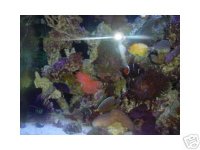I am currently buying the insides of an existing 90g reef tank to start my own brand new 55g. The tank is stable and has been for over 2yrs. It has supposidly never had a disease problem. I made a deal with my LFS (great guy) he is recieving all the fish and inverts while I will take the 90lbs LR and 80lbs LS to cycle with. We will be breaking down the 90 and setting up my 55 in the same morning. 1hr travel time between the two locations. My question is : I really don't know the history of this tank other than heresay from the "seller". What precations if any should I take and would it be wise to bring any existing water from the 90 to cycle my 55 or just use all new water? Should I dip the LR in saline to remove any undesirables or would this hurt the life on the rock. How long do you think it would take to cycle. Should I give the LS a good vacuming? Any help or advise would be appriciated.
Thank you.
Supposed reason for selling(The seller is getting ready to do a major house remodel and has to remove tank ) Attached is pic of 90
Thank you.
Supposed reason for selling(The seller is getting ready to do a major house remodel and has to remove tank ) Attached is pic of 90






